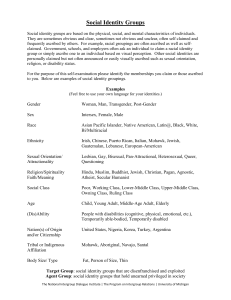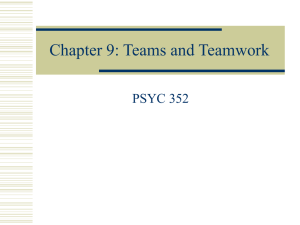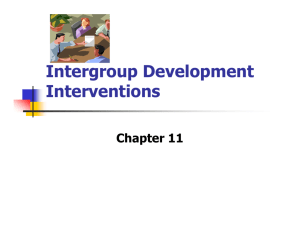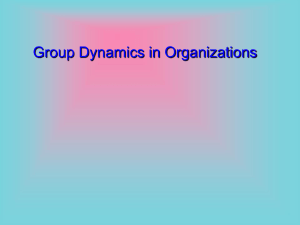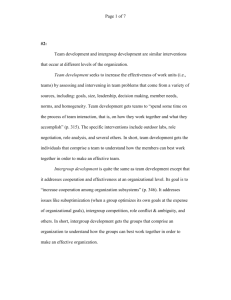Intergroup Behaviour
advertisement
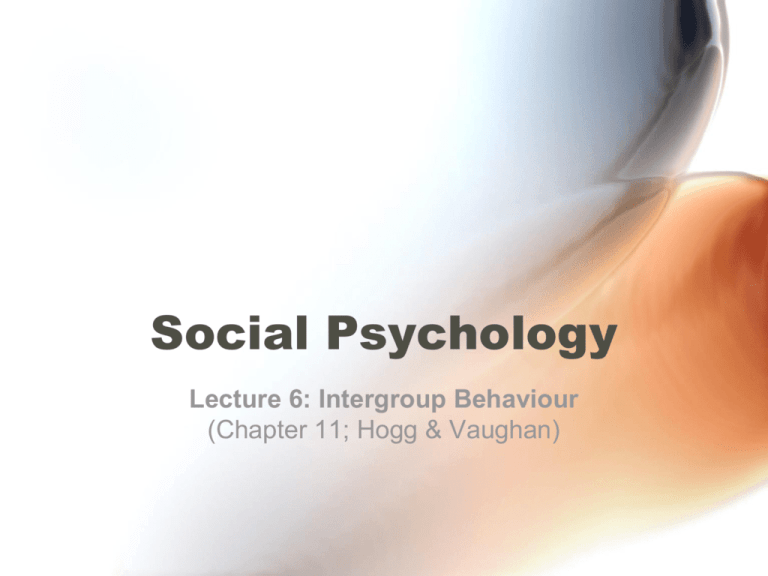
Social Psychology Lecture 6: Intergroup Behaviour (Chapter 11; Hogg & Vaughan) At the end of the lecture . . . • How have social psychologists describe and explained intergroup behaviour? • • • • • What is intergroup behaviour? Relative deprivation and social unrest Realistic conflict Social identity Improving Intergroup Relations What is intergroup behaviour? • Intergroup behaviour is any perception, cognition, or behaviour that is influenced by people’s recognition that they and others are members of distinct social groups. • International and intranational conflicts, political confrontations, revolutions, interethnic relations, negotiations between unions and management, and competitive team sports are all examples of intergroup behaviour. • Intergroup behaviour is usually competitive and ethnocentric, with people favouring their own group over outgroups, and sometimes it can become hostile and highly destructive. In understanding intergroup behaviour we are also trying to understand the conditions under which such behaviour can be shifted away from destructive hostility toward harmless competition or constructive cooperation. ) Relative deprivation and social unrest • What drives intergroup behaviour? • A sense of relative deprivation is a precursor of intergroup behaviours such as riots or other collective actions and social protests. • According to the J-curve hypothesis, when people feel that their rising expectations are no longer being met, or there is a sudden drop in attainments, they feel an acute sense of relative deprivation, which can lead to social unrest — socalled ‘revolutions of rising expectations’. Figure 11.2 The J-curve hypothesis of relative deprivation Source: Based on Davies (1969) Relative deprivation and social unrest • Not all relative deprivation produces collective action. If you feel deprived as an individual relative to other individuals (egoistic relative deprivation), you are more likely to feel depressed and de-motivated. • It is fraternalistic relative deprivation, a sense that your group is deprived relative to other groups, that plants the seeds of collective action and protest. • For fraternalistic relative deprivation to have this effect, four other conditions need to be met: – (a) you need to identify with your group, – (b) social action needs to have some chance of succeeding in addressing your deprivation, – (c) a sense of injustice, both distributive and procedural, needs to be felt, and – (d) there needs to be a relevant comparison outgroup. Relative deprivation and social unrest • Even if all the conditions are met for social protest or collective action, many sympathisers simply do not take part. • This is a manifestation of the wider problem that people’s attitudes do not readily translate into behaviour. Relative deprivation and social unrest • Attitude-behaviour correspondence is increased if people identify strongly with the group, social action is normative of group membership, people feel they have the capacity to take part, and so forth. • Social protest is also like a social dilemma. Even though effective protest benefits all, participation can be risky for the individual, so it is tempting to let others take the risk while they benefit from the success. Realistic conflict • Lead to conflict. • Ethnocentrism, a perception that all things ‘ingroup’ are superior to all things ‘outgroup’, is intrinsic to intergroup behaviour. • According to realistic conflict theory, ethnocentrism is produced when two groups have the same goal but only one group can achieve the goal, at the expense of the other. This kind of goal relationship produces competition and intergroup antipathy because the other group is effectively preventing your group from achieving its goal. • Where two groups have the same goal but the goal can only be achieved by cooperative interaction (a superordinate goal), the groups cooperate and thus help each other, producing more favourable intergroup attitudes. Figure 11.3 Realistic group conflict theory Source: Based on Sherif (1966) Social identity • Social identity is a theory formed by Tajfel and Turner to understand the psychological basis of intergroup discrimination. It comprises three elements: • Categorization: We often put others (and ourselves) into categories. Labeling someone with a certain name (lecturer, student) are ways of saying other things about these people. • Identification: We also associate with certain groups (our ingroups), which serves to bolster our self-esteem. • Comparison: We compare our groups with other groups, seeing a favorable bias toward the group to which we belong. Improving intergroup relations • At the societal level, a strategy of pluralism, or multiculturalism, holds some hope for better relations (for example, between ethnic groups within a larger nation). It nourishes a sense of cooperative intergroup relations within a wider superordinate identity, but at the same time does not threaten one's ethnic identity. Social identity • Social Identity Theory is a diffuse but interrelated group of social psychological theories concerned with when and why individuals identify with, and behave as part of, social groups, adopting shared attitudes to outsiders. • It is also concerned with what difference it makes when encounters between individuals are perceived as encounters between group members. (i.e. when you ask a question, are you asking me (john), or can it perceived as a student asking a lecturer. • Social Identity Theory is thus concerned both with the psychological and sociological aspects of group behaviour. Social identity • Such groups are mentally represented by prototypes (fuzzy sets of attributes) that capture ingroup similarities and intergroup differences in such a way (i.e., conforming to the metacontrast principle) as to maximise group distinctiveness (i.e., entitativity). • Categorization of self and others causes perception and behaviour to conform to the relevant prototype, a process of depersonalization. Establishment of norms Groups do emerge from nothing. Figure 11.15 Emergent norm theory Source: Based on Turner & Killian (1957) Social identity • How does this fit into conflict • Because people like to think positively of themselves, and social identity is self-evaluative, intergroup behaviour is a struggle to protect, maintain, or achieve evaluatively positive social identity and ingroup distinctiveness. • The strategies used to rectify unfavourable social identity depend on one’s beliefs about the nature of intergroup relations. If you believe it is easy to move into a higher status group (social mobility belief system), then that is what you will try to do. If you believe mobility is impossible (social change belief system), the status quo is legitimate, and there is no alternative system (no cognitive alternatives exist), then you will try to modify the evaluation of your group in quite creative ways (social creativity). • Direct conflict with a dominant group (social competition) arises when the status quo is recognised to be illegitimate and changeable (cognitive alternatives exist). Figure 11.6 identity Social identity theory: belief structures and strategies for improving social Improving intergroup relations • Although propaganda and public education communicate social disapproval of prejudice, they are not very effective at improving intergroup attitudes when people's day-to-day lives are permeated by bigotry and anxiety about intergroup encounters. • Bringing individuals together so they get to know one another may work better • As it is long believed that prejudice is based in ignorance and the perception of irreconcilable intergroup differences • Therefore contact causes people to recognise that they are a great deal more similar than they thought • But Improving intergroup relations • Intergroup anxiety is one of the most significant hurdles to greater contact (Stephan & Stephan, 2000). Why? – Realistic threat: A sense of a real threat to ones own group – Symbolic threat: A threat posed by the outgroup to one’s values, beliefs, morals and norms – Intergroup Anxiety: Fear of rejection or embarrassment – Negative Stereotypes: Fear of intergroup anxiety Improving intergroup relations • However contact under the right circumstances can reduce intergroup anxiety and improve intergroup attitudes (Brown & Hewstone; 2005 Pettigrew, 1998) – Prolonged and involve co-operative activity. This activity should be purposeful – Within a framework of official or institutional support for integration – Involve people (or groups) or equal social status. Unequal status contact is more likely to conform stereotypes Improving intergroup relations • Other problems • Similarity – Because groups are often very different, contact is likely to bring attention to other differences – Should we always assume different groups are similar Improving intergroup relations • Mediation – Mediation can help in several ways – Reduce emotional heath – Reduce misperceptions – Propose novel compromises – Help both parties make a graceful retreat – Inhibit unreasonable claims At the end of the lecture . . . • How have social psychologists describe and explained intergroup behaviour? • • • • • What is intergroup behaviour? Relative deprivation and social unrest Realistic conflict Social identity Improving Intergroup Relations
